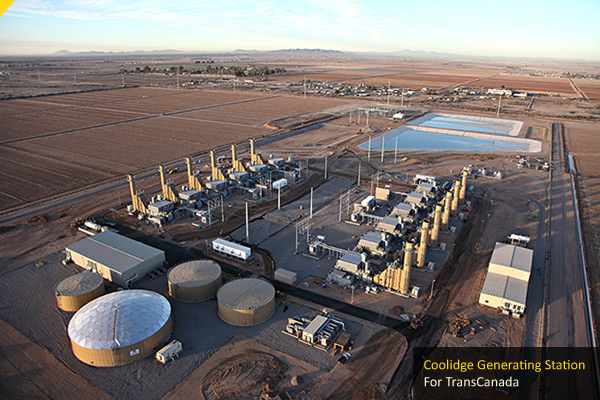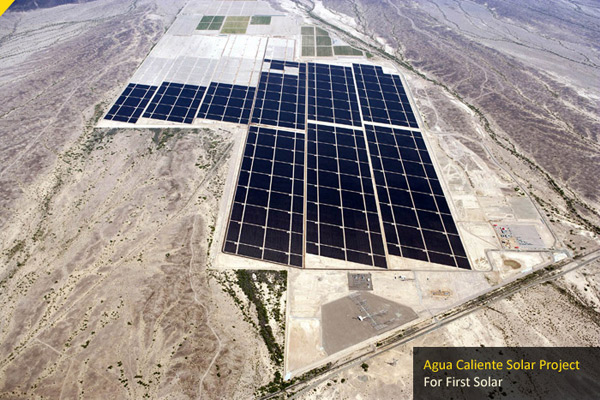
Power Plants

I provide power project siting and land related services from high level regional overviews to securing specific sites and supporting the project through the permitting and construction process. My primary goal is identifying and securing sites that offer my clients competitive advantages.
A number of professions are typically involved in the permitting and development process for a power project – surveyors, engineers, geologists, attorneys, environmental experts and others. I have worked in concert with a number of highly effective professionals with successful track records in developing major projects. If your company doesn’t have a given development skill set / function in-house I can help you put together a team.
I site renewable and conventional (natural gas fired) electricity generation / power plant projects in Arizona – and in neighboring states in cooperation with licensed brokers. The cost of bidding into an RFP for a power project can easily run to several hundred thousand dollars. Developing power projects can run from the tens of millions for a relatively small utility-scale photovoltaic facility to several hundred million and more for a large scale conventional or renewable energy power plant. A project well begun is one with a good chance of getting done – and a good power project begins with a competitive site and interconnection.
I can coordinate surveys, geotechnical drilling and other onsite activities with existing land uses such as Ag lessee(s), liaison with neighboring landowners, relevant local agencies, etc. In some cases I have provided land related support of various types well after COD.

In recent years natural gas has been the fuel of choice for new thermal generation in the US and Arizona – for both combined cycle and peaking / load-following generation. Indications are that natural gas will continue to be the fuel of choice for both new generation and repowers for the foreseeable future.
Nuclear generation could begin to make inroads depending on a number of factors including requirements associated with greenhouse gas emissions (by regulation – direct limitation, federal or state carbon tax implementation, etc.); final approval of the Yucca Mountain waste storage facility; improved technology such as pebble bed configurations.
A key consideration for new power projects is that the permitting hurdles and development timeline for a nuclear facility are significant. In contrast, permitting a new natural gas fired generating facility it relatively straightforward and a three years or less start to COD timeline is possible.
There are excellent siting options for new gas fired generation in Arizona and neighboring states – in some cases preliminary due diligence has been completed and the entitlement process is initiated to partially or entirely completed – which can be useful for prospective projects that would benefit from a shorter development process.
On the horizon – continued transition from coal to natural gas for conventional / turbine generation; new natural gas pipeline capacity in several areas in the west – including both new pipeline construction and added compression capacity for existing pipelines.

Arizona is a solar state – in every sense of the term. For utility scale solar development the trend is toward relatively smaller, more geographically and transmission diverse facilities. There are very good siting options in Arizona and neighboring states for solar projects with capacities from a few megawatts to several hundred should there be effective demand. I have sourced a number of utility scale solar sites from 20MW to 290MW capacities.
On the horizon – the potential for more demand for renewables in California; continued decrease in the cost of installed utility scale PV solar – perhaps approaching true grid parity in the next several years; improved storage technologies for PV solar.
If you need to site a conventional or renewable power project in Arizona or neighboring states I can help.
Existing Generation Assets
At any given time there can be a number of various types of existing generation assets or available for acquisition – though they may not be actively marketed by the owners. Significant amounts of gas fired generation were built in the US between 1998 and 2004, as much as 175 GW by some estimates. This resulted in an over-capacity of gas fired power plants. Many of these plants were eventually involved in bankruptcies and / or were acquired by purchases or subject to other types of succession in interests over the last ~ 10 years. Numerous power plants and groups of power assets are majority owned by lenders whose interests may be best served by divesting the subject asset(s).
To varying degrees this gas fired generation capacity has been and is being absorbed in some US markets due to demand / load growth and retirements of older facilities, including coal fired plants. I believe this trend will continue over the next several years and the capacity factors (and resulting revenues) for existing gas fired power plants will tend to increase.
The flip side is that existing generation assets will sometimes compete with newer, more efficient and optimally configured power plants. In some regions, including the western US, the effective demand and thus the focus for new construction will be power plants configured for peaking / load-following generation to backup and firm intermittent generations from renewable sources including solar and wind. A good deal of the existing gas fired generation capacity not fully contracted is not especially well suited to this purpose. Also, there is a relative abundance of capital in the power marketplace currently as investors and investment groups seek meaningful rates of return on their capital. This has fueled a renewed interest in the construction of new power plants in some regions of the US.
The numerous factors affecting the value of existing power plants and each situation is different. However, the bottom line for generation investment is the same as it is for other types of investments – does (or will) the power plant or group of power plants meet the buyer’s return on equity (ROE) or return on investment (ROI) goals? Note that risk tolerance, cost of capital and economic goals can be distinctly different for a utility than they are for private equity firm or dedicated investment fund.
It can be relatively straightforward to forecast the rate of return if the subject power plant has an existing power purchase agreement with an extended period remaining on the contract. The question is somewhat more difficult when there is not an existing power purchase agreement or when the subject plant’s annual capacity factor has been relatively low or erratic. When considering an investment in power assets it’s also important to consider how the picture may be changing for the subject power plant or group of generation assets. What meaningful changes are on the horizon – near term and long term? Will the changes be negatives or positives for the value of the subject plant or group of plants?
Considerations could include:
Availability and cost of primary inputs:
![]() Fuel – new pipeline(s) or capacity coming online; cost of natural gas
Fuel – new pipeline(s) or capacity coming online; cost of natural gas
![]() Water – will existing sources continue to be available – for example: the once through cooled (OTC) plants along the coast in California and plants across the US using river water for cooling purposes
Water – will existing sources continue to be available – for example: the once through cooled (OTC) plants along the coast in California and plants across the US using river water for cooling purposes
![]() Regulatory and systems operating changes:
Regulatory and systems operating changes:
![]() More stringent air quality standards which could require significant capital expenditure for compliance
More stringent air quality standards which could require significant capital expenditure for compliance
![]() Changes in applicable regulated rate structures
Changes in applicable regulated rate structures
![]() Changes in the applicable taxation structures
Changes in the applicable taxation structures
![]() Changes in transmission access tariffs or wheeling costs
Changes in transmission access tariffs or wheeling costs
Generation investors including private equity firms may evaluate a given power plant or group of power plants against alternative investment options – which may include other generation assets within or selling into the same market or transmission system; generation assets in entirely different markets or transmission systems; and of course non-generation assets. Generation assets can be attractive investments yielding relatively high rates of return. But owning and operating utility scale generation assets is a relatively complex and capital intensive undertaking. Investing in power plants or groups of power plants is best suited to sophisticated investors and investment firms.
If you are considering investing in a power plant or group of power plants, I can identify potential assets, research them, make confidential inquiries as appropriate to the situation, provide a preliminary estimate of value and facilitate the transaction. I will work in concert with engineers, attorneys and related professionals to complete the due diligence process as the client wishes.
This class includes rights, entitlements and allowances including emission reduction credits, water rights, firm transmission rights, fuel supply commitments, shared facility agreement and so on.
I can help identify and secure generation related / enabling assets when they are needed. I can also help divest assets that are no longer needed.